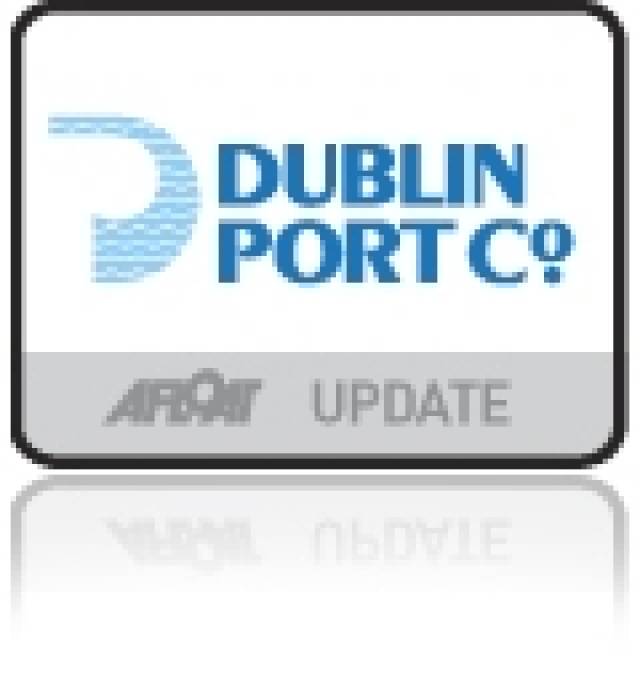#dublinport – Dublin Port Company today welcomed the decision by An Bord Pleanála to grant permission for the Alexandra Basin Redevelopment (ABR) Project which will transform Dublin Port's infrastructure and enable it to service the economy for decades ahead. The project will increase the port's ability to handle large ships by deepening and lengthening three kilometres of the port's seven kilometres of berths. It will also deepen the port to provide an entrance channel with a depth of at least 10m.
The ABR Project is the largest single infrastructure development project in the history of Dublin Port. The project is expected to take five years to complete, costing an estimated €230m.
Given the port's sensitive location at the heart of Dublin Bay and Dublin City, the project was subjected to a rigorous assessment by An Bord Pleanála of possible impacts on the environment generally and specifically on protected Natura sites.
Today's decision comes as trade volumes continue to rise at Dublin Port with 2015 set to be a record year. New figures show total throughput (imports and exports) rose by 5.0% in the first half of 2015 with imports growing particularly strongly at 5.6% as the domestic economy improves.
As well as being a record year for cargo, 2015 will be a record year for the port's cruise business with nearly 100 cruise ships bringing 200,000 visitors to Dublin expected for the full year. These include some of the world's largest cruise ships such as MSC Splendida, Royal Princess and Celebrity Silhouette, measuring up to 333m long. Until now these ships have had to reverse into Dublin Port given their lengths. The ABR Project will allow larger ships to routinely call at Dublin, turn within Alexandra Basin and berth as far upriver as East Link Bridge. This will create a positive economic impact for the city, enhance inbound tourism and contribute to the development of Docklands.
The port is also seeing strong growth in ferry passenger numbers, up 4.8% in the six months to June on routes between Dublin and Britain and between Dublin and France.
Eamonn O'Reilly, Chief Executive of Dublin Port Company said: "I am delighted that An Bord Pleanála has granted Dublin Port planning permission for the ABR Project and to say that we can finance the project immediately. The engineering design works are already at an advanced stage and we expect the first phase of works to be tendered and a contractor ready to start by October 2015."
"The ABR Project is a complex undertaking that required co-ordinated planning with a range of bodies including Dublin City Council, the National Roads Authority (NRA), the National Transport Agency (NTA), ESB Networks and Eirgrid. I am pleased to say that all of our dealings were positive and supportive. We have achieved strong consensus on how to deliver this major piece of port infrastructure in a way that is compatible with the operations of other major infrastructure providers within and adjacent to the port."
An Bord Pleanála's planning permission has paved the way for the last remaining steps to deliver the ABR Project in good time. The priority now is for Dublin Port to begin the engineering works as soon as possible. Against a background of strong growth in port volumes, there is still a window of opportunity in which to carry out major construction works before volumes grow to the extent that the port has to turn some trade away during the construction phase.
To capitalise on this window, Dublin Port's next focus is on progressing the other consents required from the Department of Environment, Community and Local Government and from the Environmental Protection Agency (EPA). Having liaised with both organisations throughout the planning application, Dublin Port hopes to secure the necessary consents within months.
The ABR Project is the first major project from Dublin Port's Masterplan 2012 to 2040. While bringing it through the planning process, Dublin Port Company has also been working on smaller projects including a new terminal for imported cars, a new high capacity firewater main and completion of the Alexandra Quay Container Terminal. The redevelopment of eight hectares of land within the port is also underway and Dublin Port Company will shortly lodge a planning application with Dublin City Council to redevelop the port's road network to ensure it has the capacity to handle the doubling in port volumes projected by 2040.
Dublin Port is Ireland's largest port and is one of 83 core ports on the EU's TEN-T network. In October 2014, the EU agreed funding of €2.4m towards Dublin Port Company's costs of bringing the ABR Project through to the point of being ready for construction.1
Following on from this, on 30th June 2015, the European Commission announced further funding of €22.8m for the construction phase of the project. 2 Finally, the project is also under appraisal by the European Investment Bank (EIB) for €100m of long-term debt finance. 3
Eamonn O'Reilly, Chief Executive of Dublin Port Company said: "The positive decsision by An Bord Pleanála and the financial support from the EU and EIB put us in a good position to commence construction works later this year subject to our gaining the remaining necessary consents from the EPA and the Department of the Environment, Community and Local Government. Bringing large infrastructure projects through to the construction phase is a long, detailed and careful process. Given our high growth rates, we intend to review our Masterplan 2012 to 2040 in the first quarter of next year and begin to plan the next major development after the ABR Project."
































































